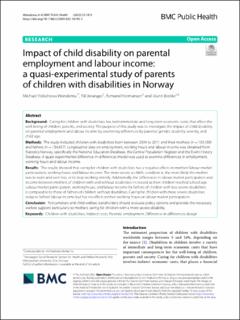| dc.contributor.author | Wondemu, Michael Yisfashewa | |
| dc.contributor.author | Joranger, Pål | |
| dc.contributor.author | Hermansen, Åsmund | |
| dc.contributor.author | Brekke, Idunn | |
| dc.date.accessioned | 2023-02-15T12:48:22Z | |
| dc.date.available | 2023-02-15T12:48:22Z | |
| dc.date.created | 2022-09-28T07:44:13Z | |
| dc.date.issued | 2022-09-24 | |
| dc.identifier.issn | 1471-2458 | |
| dc.identifier.uri | https://hdl.handle.net/11250/3051133 | |
| dc.description.abstract | Background: Caring for children with disabilities has both immediate and long-term economic costs that affect the well-being of children, parents, and society. The purpose of this study was to investigate the impact of child disability on parental employment and labour income by examining differences by parental gender, disability severity, and child age.
Methods: The study included children with disabilities born between 2004 to 2011 and their mothers (n = 139,189) and fathers (n = 134,457). Longitudinal data on employment, working hours and labour income was obtained from Statistics Norway, specifically the National Education Database, the Central Population Register and the Event History Database. A quasi-experimental difference-in-differences model was used to examine differences in employment, working hours and labour income.
Results: The results showed that caring for children with disabilities has a negative effect on mothers’ labour market participation, working hours and labour income. The more severe a child’s condition is, the more likely the mother was to work and earn less, or to stop working entirely. Additionally, the differences in labour market participation and income between mothers of children with and without disabilities increased as their children reached school age. Labour market participation, working hours, and labour income for fathers of children with less severe disabilities is comparable to those of fathers of children without disabilities. Caring for children with more severe disabilities reduces fathers’ labour income but has no effect on their working hours or labour market participation.
Conclusion: Policymakers and child welfare stakeholders should evaluate policy options and provide the necessary welfare support particularly to mothers caring for children with a more severe disability. | en_US |
| dc.language.iso | eng | en_US |
| dc.publisher | BMC | en_US |
| dc.relation.ispartofseries | BMC Public Health;22, Article number: 1813 (2022) | |
| dc.rights | Navngivelse 4.0 Internasjonal | * |
| dc.rights.uri | http://creativecommons.org/licenses/by/4.0/deed.no | * |
| dc.subject | Children with disabilities | en_US |
| dc.subject | Disabled children | en_US |
| dc.subject | Indirect costs | en_US |
| dc.subject | Parental employment | en_US |
| dc.subject | Difference-in-differences design | en_US |
| dc.title | Impact of child disability on parental employment and labour income: a quasi‑experimental study of parents of children with disabilities in Norway | en_US |
| dc.type | Peer reviewed | en_US |
| dc.type | Journal article | en_US |
| dc.description.version | publishedVersion | en_US |
| dc.rights.holder | © The Author(s) 2022 | en_US |
| dc.source.articlenumber | 1813 | en_US |
| cristin.ispublished | true | |
| cristin.fulltext | original | |
| cristin.qualitycode | 1 | |
| dc.identifier.doi | https://doi.org/10.1186/s12889-022-14195-5 | |
| dc.identifier.cristin | 2056114 | |
| dc.source.journal | BMC Public Health | en_US |
| dc.source.volume | 22 | en_US |
| dc.source.issue | 22 | en_US |
| dc.source.pagenumber | 1-11 | en_US |
| dc.relation.project | Norges forskningsråd: 301666 | en_US |

